Zhiliang Peng
VibeVoice Technical Report
Aug 26, 2025Abstract:This report presents VibeVoice, a novel model designed to synthesize long-form speech with multiple speakers by employing next-token diffusion, which is a unified method for modeling continuous data by autoregressively generating latent vectors via diffusion. To enable this, we introduce a novel continuous speech tokenizer that, when compared to the popular Encodec model, improves data compression by 80 times while maintaining comparable performance. The tokenizer effectively preserves audio fidelity while significantly boosting computational efficiency for processing long sequences. Thus, VibeVoice can synthesize long-form speech for up to 90 minutes (in a 64K context window length) with a maximum of 4 speakers, capturing the authentic conversational ``vibe'' and surpassing open-source and proprietary dialogue models.
Multimodal Latent Language Modeling with Next-Token Diffusion
Dec 11, 2024



Abstract:Multimodal generative models require a unified approach to handle both discrete data (e.g., text and code) and continuous data (e.g., image, audio, video). In this work, we propose Latent Language Modeling (LatentLM), which seamlessly integrates continuous and discrete data using causal Transformers. Specifically, we employ a variational autoencoder (VAE) to represent continuous data as latent vectors and introduce next-token diffusion for autoregressive generation of these vectors. Additionally, we develop $\sigma$-VAE to address the challenges of variance collapse, which is crucial for autoregressive modeling. Extensive experiments demonstrate the effectiveness of LatentLM across various modalities. In image generation, LatentLM surpasses Diffusion Transformers in both performance and scalability. When integrated into multimodal large language models, LatentLM provides a general-purpose interface that unifies multimodal generation and understanding. Experimental results show that LatentLM achieves favorable performance compared to Transfusion and vector quantized models in the setting of scaling up training tokens. In text-to-speech synthesis, LatentLM outperforms the state-of-the-art VALL-E 2 model in speaker similarity and robustness, while requiring 10x fewer decoding steps. The results establish LatentLM as a highly effective and scalable approach to advance large multimodal models.
Kosmos-G: Generating Images in Context with Multimodal Large Language Models
Oct 04, 2023Abstract:Recent advancements in text-to-image (T2I) and vision-language-to-image (VL2I) generation have made significant strides. However, the generation from generalized vision-language inputs, especially involving multiple images, remains under-explored. This paper presents Kosmos-G, a model that leverages the advanced perception capabilities of Multimodal Large Language Models (MLLMs) to tackle the aforementioned challenge. Our approach aligns the output space of MLLM with CLIP using the textual modality as an anchor and performs compositional instruction tuning on curated data. Kosmos-G demonstrates a unique capability of zero-shot multi-entity subject-driven generation. Notably, the score distillation instruction tuning requires no modifications to the image decoder. This allows for a seamless substitution of CLIP and effortless integration with a myriad of U-Net techniques ranging from fine-grained controls to personalized image decoder variants. We posit Kosmos-G as an initial attempt towards the goal of "image as a foreign language in image generation."
Kosmos-2: Grounding Multimodal Large Language Models to the World
Jul 13, 2023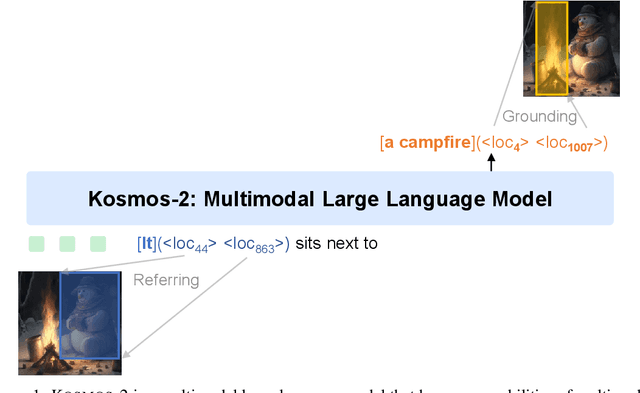



Abstract:We introduce Kosmos-2, a Multimodal Large Language Model (MLLM), enabling new capabilities of perceiving object descriptions (e.g., bounding boxes) and grounding text to the visual world. Specifically, we represent refer expressions as links in Markdown, i.e., ``[text span](bounding boxes)'', where object descriptions are sequences of location tokens. Together with multimodal corpora, we construct large-scale data of grounded image-text pairs (called GrIT) to train the model. In addition to the existing capabilities of MLLMs (e.g., perceiving general modalities, following instructions, and performing in-context learning), Kosmos-2 integrates the grounding capability into downstream applications. We evaluate Kosmos-2 on a wide range of tasks, including (i) multimodal grounding, such as referring expression comprehension, and phrase grounding, (ii) multimodal referring, such as referring expression generation, (iii) perception-language tasks, and (iv) language understanding and generation. This work lays out the foundation for the development of Embodiment AI and sheds light on the big convergence of language, multimodal perception, action, and world modeling, which is a key step toward artificial general intelligence. Code and pretrained models are available at https://aka.ms/kosmos-2.
Generic-to-Specific Distillation of Masked Autoencoders
Feb 28, 2023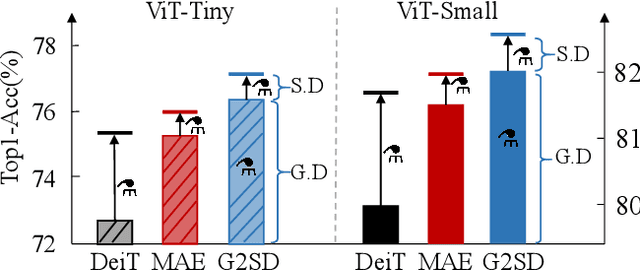
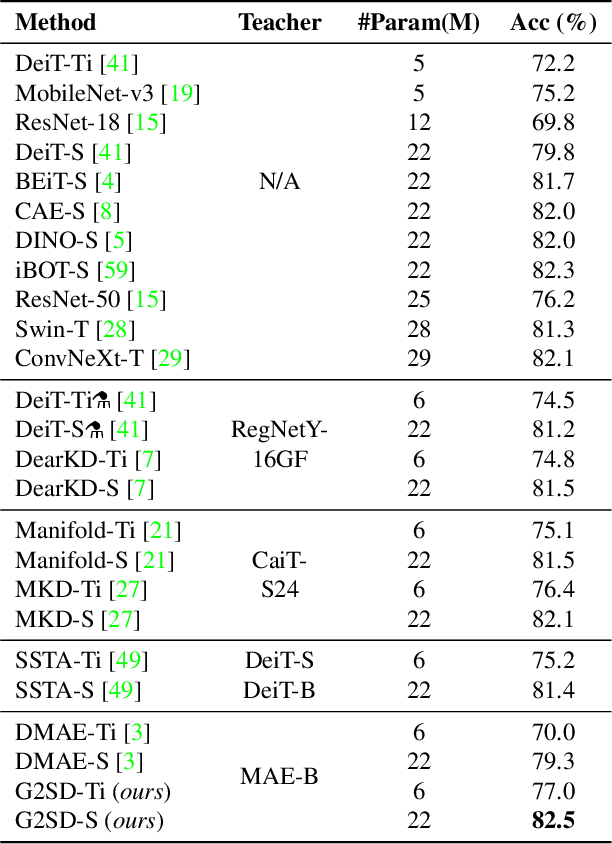
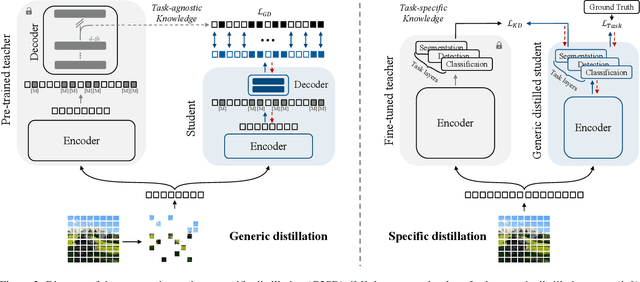
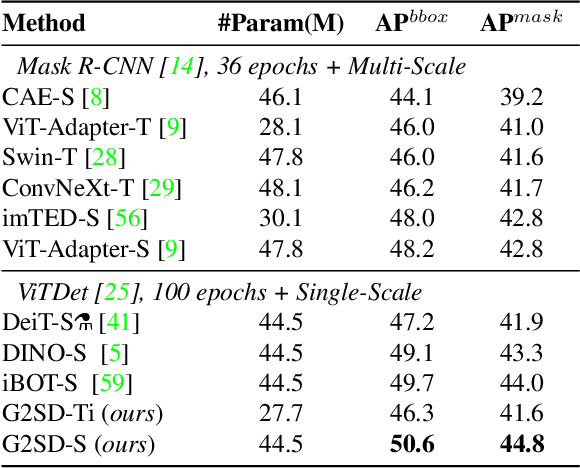
Abstract:Large vision Transformers (ViTs) driven by self-supervised pre-training mechanisms achieved unprecedented progress. Lightweight ViT models limited by the model capacity, however, benefit little from those pre-training mechanisms. Knowledge distillation defines a paradigm to transfer representations from large (teacher) models to small (student) ones. However, the conventional single-stage distillation easily gets stuck on task-specific transfer, failing to retain the task-agnostic knowledge crucial for model generalization. In this study, we propose generic-to-specific distillation (G2SD), to tap the potential of small ViT models under the supervision of large models pre-trained by masked autoencoders. In generic distillation, decoder of the small model is encouraged to align feature predictions with hidden representations of the large model, so that task-agnostic knowledge can be transferred. In specific distillation, predictions of the small model are constrained to be consistent with those of the large model, to transfer task-specific features which guarantee task performance. With G2SD, the vanilla ViT-Small model respectively achieves 98.7%, 98.1% and 99.3% the performance of its teacher (ViT-Base) for image classification, object detection, and semantic segmentation, setting a solid baseline for two-stage vision distillation. Code will be available at https://github.com/pengzhiliang/G2SD.
A Unified View of Masked Image Modeling
Oct 19, 2022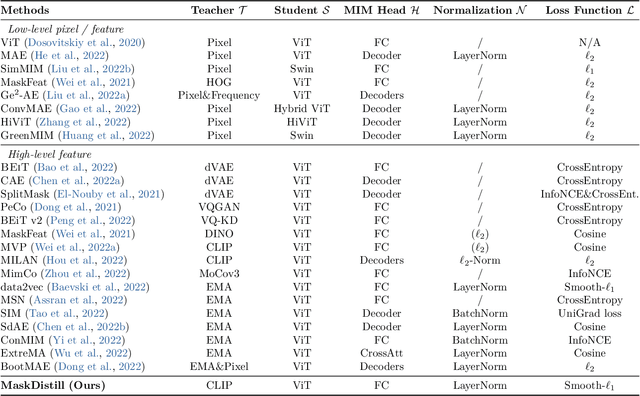
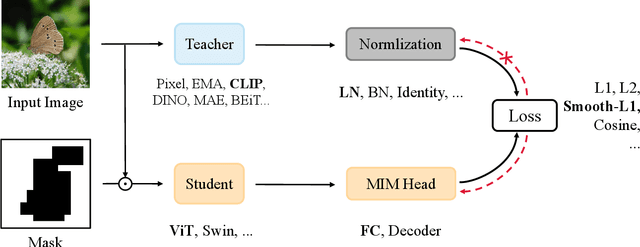
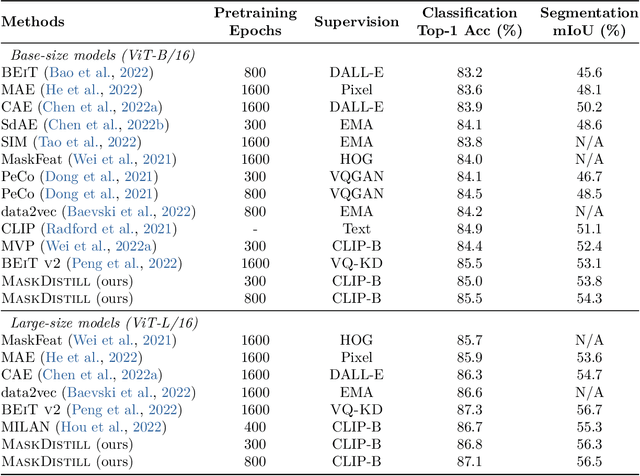

Abstract:Masked image modeling has demonstrated great potential to eliminate the label-hungry problem of training large-scale vision Transformers, achieving impressive performance on various downstream tasks. In this work, we propose a unified view of masked image modeling after revisiting existing methods. Under the unified view, we introduce a simple yet effective method, termed as MaskDistill, which reconstructs normalized semantic features from teacher models at the masked positions, conditioning on corrupted input images. Experimental results on image classification and semantic segmentation show that MaskDistill achieves comparable or superior performance than state-of-the-art methods. When using the huge vision Transformer and pretraining 300 epochs, MaskDistill obtains 88.3% fine-tuning top-1 accuracy on ImageNet-1k (224 size) and 58.8% semantic segmentation mIoU metric on ADE20k (512 size). The code and pretrained models will be available at https://aka.ms/unimim.
Foundation Transformers
Oct 19, 2022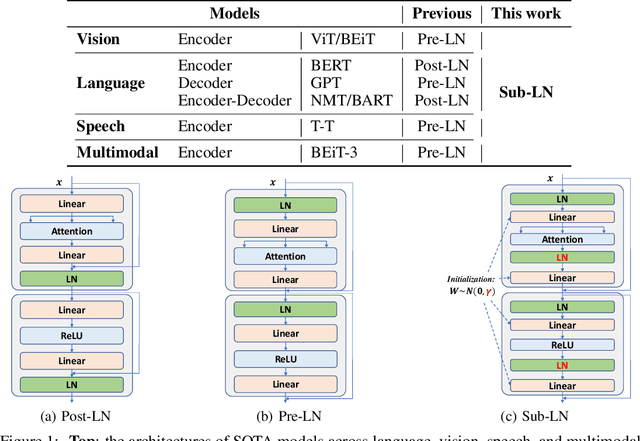
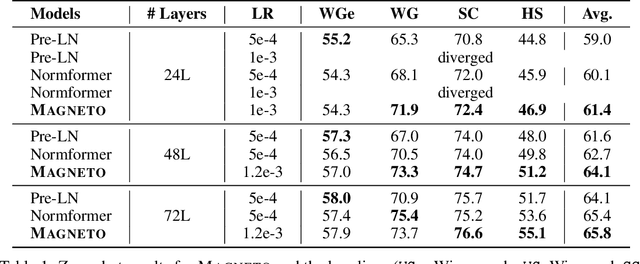
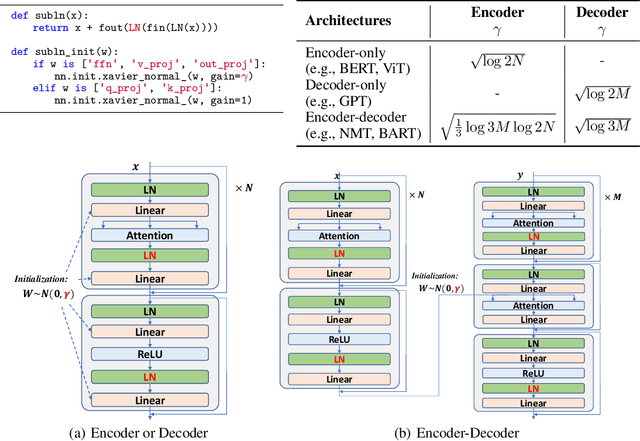
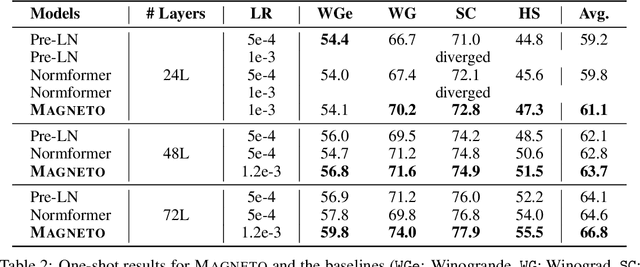
Abstract:A big convergence of model architectures across language, vision, speech, and multimodal is emerging. However, under the same name "Transformers", the above areas use different implementations for better performance, e.g., Post-LayerNorm for BERT, and Pre-LayerNorm for GPT and vision Transformers. We call for the development of Foundation Transformer for true general-purpose modeling, which serves as a go-to architecture for various tasks and modalities with guaranteed training stability. In this work, we introduce a Transformer variant, named Magneto, to fulfill the goal. Specifically, we propose Sub-LayerNorm for good expressivity, and the initialization strategy theoretically derived from DeepNet for stable scaling up. Extensive experiments demonstrate its superior performance and better stability than the de facto Transformer variants designed for various applications, including language modeling (i.e., BERT, and GPT), machine translation, vision pretraining (i.e., BEiT), speech recognition, and multimodal pretraining (i.e., BEiT-3).
Image as a Foreign Language: BEiT Pretraining for All Vision and Vision-Language Tasks
Aug 31, 2022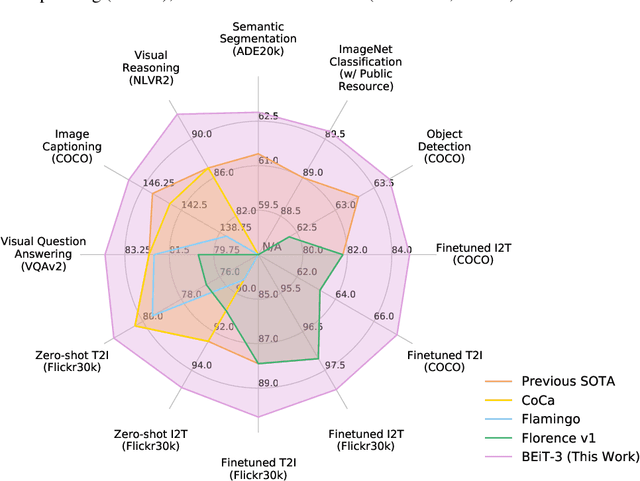
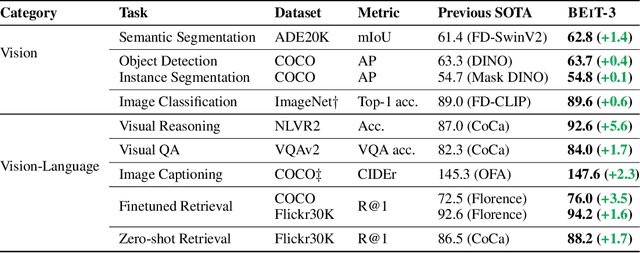
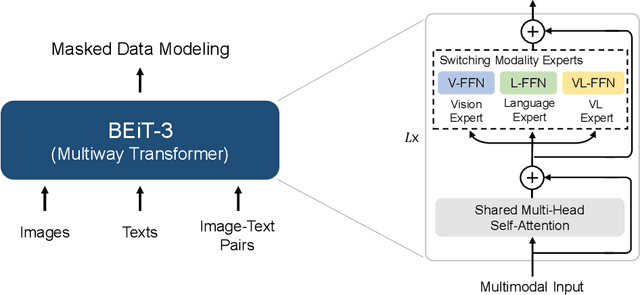

Abstract:A big convergence of language, vision, and multimodal pretraining is emerging. In this work, we introduce a general-purpose multimodal foundation model BEiT-3, which achieves state-of-the-art transfer performance on both vision and vision-language tasks. Specifically, we advance the big convergence from three aspects: backbone architecture, pretraining task, and model scaling up. We introduce Multiway Transformers for general-purpose modeling, where the modular architecture enables both deep fusion and modality-specific encoding. Based on the shared backbone, we perform masked "language" modeling on images (Imglish), texts (English), and image-text pairs ("parallel sentences") in a unified manner. Experimental results show that BEiT-3 obtains state-of-the-art performance on object detection (COCO), semantic segmentation (ADE20K), image classification (ImageNet), visual reasoning (NLVR2), visual question answering (VQAv2), image captioning (COCO), and cross-modal retrieval (Flickr30K, COCO).
BEiT v2: Masked Image Modeling with Vector-Quantized Visual Tokenizers
Aug 12, 2022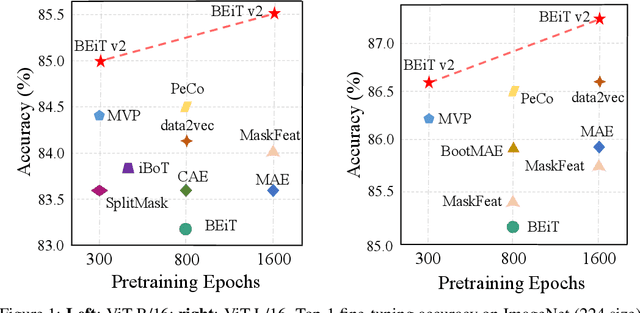
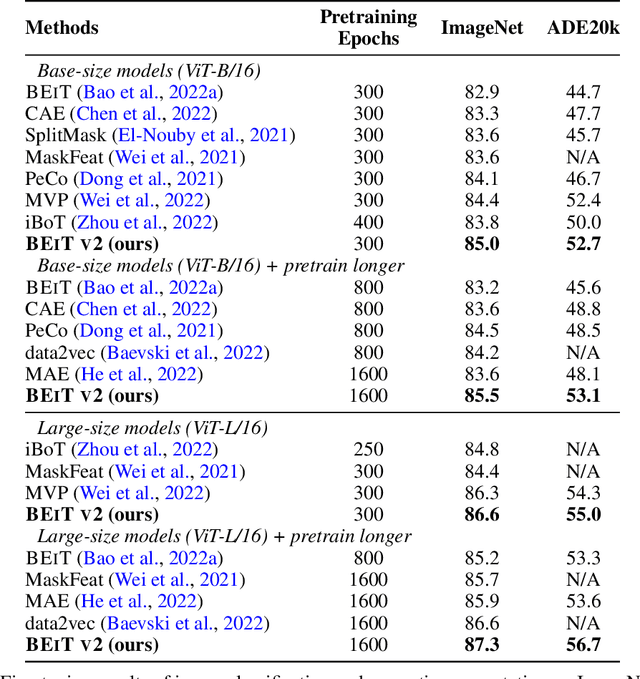
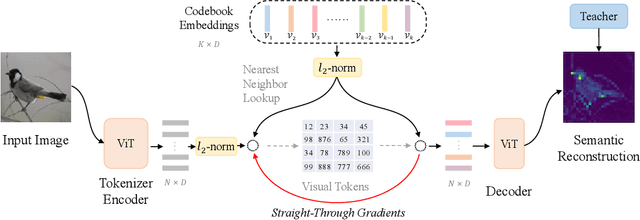
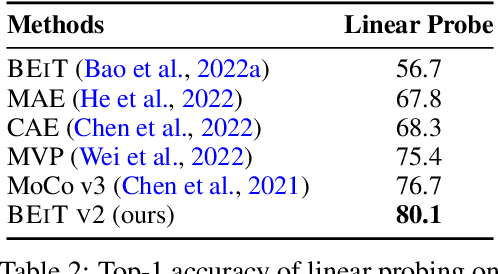
Abstract:Masked image modeling (MIM) has demonstrated impressive results in self-supervised representation learning by recovering corrupted image patches. However, most methods still operate on low-level image pixels, which hinders the exploitation of high-level semantics for representation models. In this study, we propose to use a semantic-rich visual tokenizer as the reconstruction target for masked prediction, providing a systematic way to promote MIM from pixel-level to semantic-level. Specifically, we introduce vector-quantized knowledge distillation to train the tokenizer, which discretizes a continuous semantic space to compact codes. We then pretrain vision Transformers by predicting the original visual tokens for the masked image patches. Moreover, we encourage the model to explicitly aggregate patch information into a global image representation, which facilities linear probing. Experiments on image classification and semantic segmentation show that our approach outperforms all compared MIM methods. On ImageNet-1K (224 size), the base-size BEiT v2 achieves 85.5% top-1 accuracy for fine-tuning and 80.1% top-1 accuracy for linear probing. The large-size BEiT v2 obtains 87.3% top-1 accuracy for ImageNet-1K (224 size) fine-tuning, and 56.7% mIoU on ADE20K for semantic segmentation. The code and pretrained models are available at https://aka.ms/beit.
Integral Migrating Pre-trained Transformer Encoder-decoders for Visual Object Detection
May 19, 2022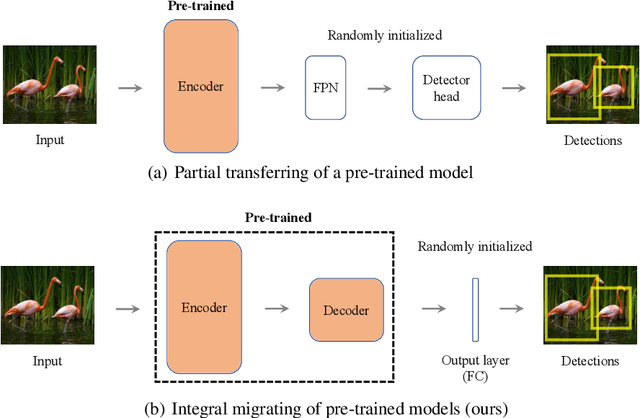



Abstract:Modern object detectors have taken the advantages of pre-trained vision transformers by using them as backbone networks. However, except for the backbone networks, other detector components, such as the detector head and the feature pyramid network, remain randomly initialized, which hinders the consistency between detectors and pre-trained models. In this study, we propose to integrally migrate the pre-trained transformer encoder-decoders (imTED) for object detection, constructing a feature extraction-operation path that is not only "fully pre-trained" but also consistent with pre-trained models. The essential improvements of imTED over existing transformer-based detectors are twofold: (1) it embeds the pre-trained transformer decoder to the detector head; and (2) it removes the feature pyramid network from the feature extraction path. Such improvements significantly reduce the proportion of randomly initialized parameters and enhance the generation capability of detectors. Experiments on MS COCO dataset demonstrate that imTED consistently outperforms its counterparts by ~2.8% AP. Without bells and whistles, imTED improves the state-of-the-art of few-shot object detection by up to 7.6% AP, demonstrating significantly higher generalization capability. Code will be made publicly available.
 Add to Chrome
Add to Chrome Add to Firefox
Add to Firefox Add to Edge
Add to Edge